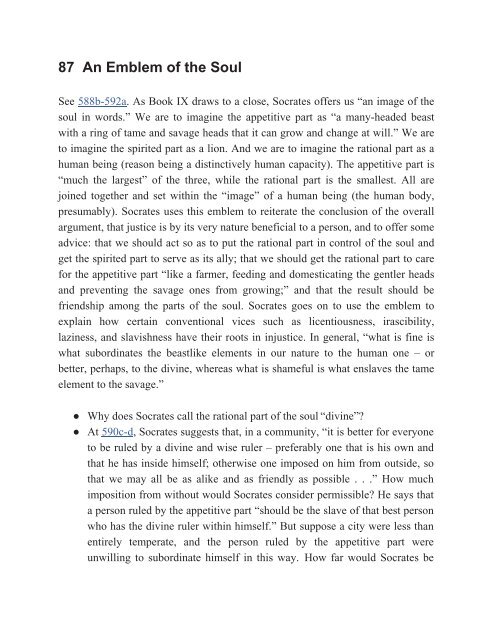The Intelligent Troglodyte’s Guide to Plato’s Republic, 2016a
The Intelligent Troglodyte’s Guide to Plato’s Republic, 2016a
The Intelligent Troglodyte’s Guide to Plato’s Republic, 2016a
You also want an ePaper? Increase the reach of your titles
YUMPU automatically turns print PDFs into web optimized ePapers that Google loves.
87 An Emblem of the Soul<br />
See 588b-592a. As Book IX draws <strong>to</strong> a close, Socrates offers us “an image of the<br />
soul in words.” We are <strong>to</strong> imagine the appetitive part as “a many-headed beast<br />
with a ring of tame and savage heads that it can grow and change at will.” We are<br />
<strong>to</strong> imagine the spirited part as a lion. And we are <strong>to</strong> imagine the rational part as a<br />
human being (reason being a distinctively human capacity). <strong>The</strong> appetitive part is<br />
“much the largest” of the three, while the rational part is the smallest. All are<br />
joined <strong>to</strong>gether and set within the “image” of a human being (the human body,<br />
presumably). Socrates uses this emblem <strong>to</strong> reiterate the conclusion of the overall<br />
argument, that justice is by its very nature beneficial <strong>to</strong> a person, and <strong>to</strong> offer some<br />
advice: that we should act so as <strong>to</strong> put the rational part in control of the soul and<br />
get the spirited part <strong>to</strong> serve as its ally; that we should get the rational part <strong>to</strong> care<br />
for the appetitive part “like a farmer, feeding and domesticating the gentler heads<br />
and preventing the savage ones from growing;” and that the result should be<br />
friendship among the parts of the soul. Socrates goes on <strong>to</strong> use the emblem <strong>to</strong><br />
explain how certain conventional vices such as licentiousness, irascibility,<br />
laziness, and slavishness have their roots in injustice. In general, “what is fine is<br />
what subordinates the beastlike elements in our nature <strong>to</strong> the human one – or<br />
better, perhaps, <strong>to</strong> the divine, whereas what is shameful is what enslaves the tame<br />
element <strong>to</strong> the savage.”<br />
Why does Socrates call the rational part of the soul “divine”?<br />
At 590c-d, Socrates suggests that, in a community, “it is better for everyone<br />
<strong>to</strong> be ruled by a divine and wise ruler – preferably one that is his own and<br />
that he has inside himself; otherwise one imposed on him from outside, so<br />
that we may all be as alike and as friendly as possible . . .” How much<br />
imposition from without would Socrates consider permissible? He says that<br />
a person ruled by the appetitive part “should be the slave of that best person<br />
who has the divine ruler within himself.” But suppose a city were less than<br />
entirely temperate, and the person ruled by the appetitive part were<br />
unwilling <strong>to</strong> subordinate himself in this way. How far would Socrates be


















